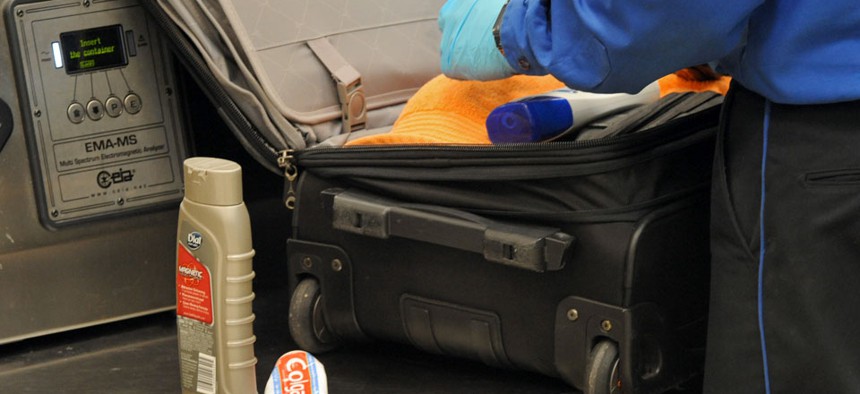Can You Profile a Suitcase? You Could Win a $15,000 Prize

A Transportation Security Administration officer discovers unallowable liquids in a passenger's carry on luggage at the security checkpoint at Hartsfield-Jackson Atlanta International Airport. Erik S. Lesser/AP File Photo
To save time inspecting low-risk bags, TSA wants to link baggage tags with passengers’ personal data.
This story has been updated to include a comment from TSA.
The Transportation Security Administration will pony up $15,000 for an idea for a system that crosschecks baggage tags against fliers’ personal data to determine the threat-level of their bags.
The thinking is that this data exchange will save screeners time fumbling through low-risk suitcases. That way, they can focus on bigger dangers.
Contestants in the public challenge have a little less than one month to describe “a day in the life of a bag” traveling through the proposed ID system, according to details posted on the website InnoCentive. The site is used for crowdsourcing solutions to problems. Submissions must detail the flow of information for linking "risk status with a bag," TSA officials said.
Today, screeners at airport checkpoints direct passengers to various lines based on a risk-level derived from watchlists that is encoded in their boarding passes. There is no such security intelligence embedded in their baggage tags, according to the agency.
"TSA is looking for new and innovative means to associate an individual's screening designation with their checked baggage," TSA officials announced Monday afternoon. "This will allow bags to be routed for varying and appropriate levels of screening in accordance with their associated screening designation and would result in a more efficient and effective use of TSA resources."
The competition asks citizens to improve upon the standard paper tag using retail anti-theft devices and E-Z Pass-like trackers, among other techniques. Or participants can suggest a completely novel approach.
Entrants must file a proposal by Sept. 8 to be eligible for a $15,000 reward.
Some examples of potential winning solutions include paper labels embedded with RFID chips. Another option might be a highly intelligent barcode that would pack much more data into a small space than the barcodes on today’s tags. This would encode a passenger's security status and flight information right on the label.
Also welcome are suggestions that use QR codes and "permanent RFID tags,” according to the rules. Or tinkerers can submit a whole new concept that uses different types of media, data exchange setups or other unexplored tools.
TSA right now only wants a plan on paper. But contenders are asked to indicate "if they are interested in a continued collaboration with the TSA" to potentially deploy the technology at airports nationwide.
TSA has labeled suitcase profiling a core investment, along with tools such as robotic body scans that spot suspicious items so passengers don't have to strip down. Core investments will account for most -- 70 percent -- of the $2.2 billion the agency might spend on technology and infrastructure over the next five years.
On Wednesday, TSA spokesman Ross Feinstein said in an email the agency views the contest as a way to tweak the funding plan. TSA "aims to encourage collaboration and generate new ideas and areas for refinement," he said. "TSA is building on this plan by leveraging innovation and out-of-the-box thinking via the InnoCentive Challenge."
Judges will evaluate the cost of the proposition with an eye toward generating "a positive return on investment within 20 years," the contest details state.
TSA wants to be able to turn bring the plan to life within one to two years. Contests must list a description of the tag format, messaging protocols and physical system needs in their application forms.
This is the second $15,000 prize TSA has offered in the past month to expedite screening procedures. The deadline for entering a competition to design a faster waiting line system is Friday.






